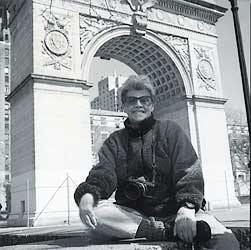Bettye Lane facts for kids
Quick facts for kids
Bettye Lane
|
|
|---|---|

Bettye Lane at the Washington Square Arch.
|
|
| Born |
Elisabetta Foti
September 19, 1930 Boston, Massachusetts
|
| Died | September 19, 2012 (aged 82) New York, New York
|
| Nationality | American |
| Education | Boston University |
| Known for | Photography, photojournalism |
Bettye Lane was a famous American photographer. She was born in Boston, Massachusetts, on September 19, 1930. She passed away in Manhattan, New York, on her birthday in 2012. Bettye was known for taking pictures of big moments in history. She photographed events related to the women's rights movement, the civil rights movement, and the fight for equal rights for all people. Her photos appeared in many well-known magazines and newspapers.
Bettye's amazing photos have been shown in famous places like the Smithsonian Institution. Some of her pictures are kept forever at the National Museum of Women in the Arts. You can also find her work in big libraries, like the New York Public Library and those at Harvard and Duke University. Her photos have even been used in movies and books! Bettye Lane died on her 82nd birthday.
Contents
Early Life and Challenges
Bettye Lane was born Elisabetta Foti. She was one of eight children. Her parents, Luigi and Antonietta Foti, were immigrants from Italy. When her father went back to Italy, her mother had a hard time paying for everything. For a while, Bettye had to live with a wealthier family.
Later, Bettye had to leave elementary school. She started working in a shoe factory to help her family. After a short marriage, she moved to New York. She kept her married name, Lane.
Becoming a Photojournalist
Bettye Lane started learning about public relations in 1959. She went to Boston University to study communications. She finished school in 1962. During this time, she also worked at the Harvard University News Office. This helped her learn about current events.
In 1960, CBS television hired Bettye. All this experience prepared her for her first job as a photojournalist. In 1962, the Saturday Evening Post hired her. She worked there until 1964.
In 1966, the National Observer hired Bettye. She stayed there until 1977. She met the newspaper's photo editor at a protest. He was very impressed by her dedication. He hired her and helped her become known as the official photographer of the women's movement.
Documenting History
While working at the National Observer, Bettye got her big chance. In 1970, she covered the first Women's Strike for Equality. This protest was organized by the National Organization for Women. It fought for women to have equal opportunities at work.
After photographing this event, Bettye became very interested in the women's movement. She made it her goal to photograph every protest and rally. She did this whether she was assigned to or not. This dedication made her known as the official photographer of the women's movement.
After leaving the National Observer in 1977, Bettye worked independently. She took assignments from Time, Life, and the Associated Press.
Bettye focused her work on important events. She photographed civil rights demonstrations. She also took pictures of protests during the Vietnam War. She documented marches for equal rights for all people. She was one of the few photographers to capture the Stonewall riots. These events in Greenwich Village are seen as the start of the fight for equal rights for all people in the United States.
Legacy and Impact
Bettye Lane passed away on September 19, 2012. She had faced several health problems. She is remembered as "the official photographer of the women's movement." Her photos have been shown in over 70 movies and books about the Stonewall riots.
One of her photos was even included in a special US Postal stamp series in 2000. Author and activist Sarah Schulman said that Bettye's photos from that time are "classics." They show women, men, and people of color who were important to the movement.
Bettye spent her later years organizing her photographs. She donated them to different organizations. She wanted to share the history of the women's movement. Her work is kept safe at places like the Schlesinger Library at Harvard University. It is also at the Library of Congress and the National Museum of Women in the Arts. You can also find her work at the New York Public Library and the Rubenstein Library at Duke University.
Unique Photographs
Bettye Lane's photographs are special. While she did photograph important leaders, she also focused on everyday people. She captured ordinary people during the protests. She believed these photos showed the true feelings and spirit of the women's movement better than pictures of just leaders.
Images for kids


